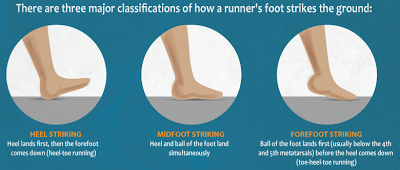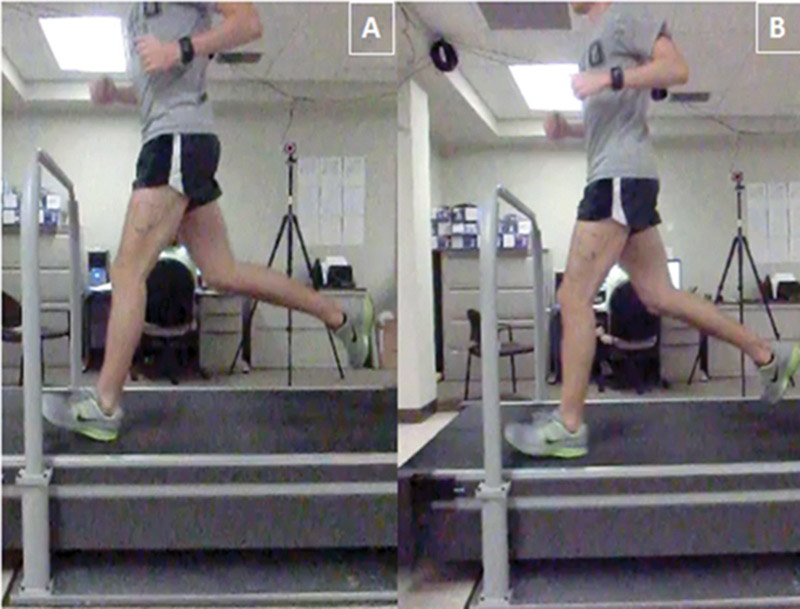Footstrike – Should You Worry About It?
 Are you a heel striker? Most likely. Perhaps you connect with the ground with the entire foot at once (mid-foot)? Or maybe you're one of the few that land with the ball of the foot first (forefoot)?
Are you a heel striker? Most likely. Perhaps you connect with the ground with the entire foot at once (mid-foot)? Or maybe you're one of the few that land with the ball of the foot first (forefoot)?
Does it even matter?
Yes and no. It depends. Hopefully by now you know there are no absolutes with this stuff. (Run the other way if someone preaches one way for everyone) Here are two things to think about regarding footstrike. As you consider these points, keep in mind that everyone is different and arrives at a running with their own unique set of history, movement patterns, skill, strength, endurance, etc.
Land With Your Foot Beneath The Body
Regardless of exactly which part of your foot hits the ground first, you need to position your leg in such a way that it will absorb impact efficiently AND not slow you down.  For teaching purposes I'll typically cue someone to simply put their foot down “earlier”. Sprinters think of stepping “over and down” and I like that for distance runners, too, with less emphasis on “over” and more on “down”.
For teaching purposes I'll typically cue someone to simply put their foot down “earlier”. Sprinters think of stepping “over and down” and I like that for distance runners, too, with less emphasis on “over” and more on “down”.
A quick way to determine if you're overstriding is to have someone take a picture of your stride. Notice the angle of your shin as your foot makes initial contact with the ground. The closer that shin is to vertical, the better the body can tolerate load and dissipate force throughout your body. A locked out knee is not a good shock absorber!
Make Sure Your Foot Is Relaxed Before Impact
Toes pointed, calf tensed, braced for impact. THIS is the most common error I encounter during my comprehensive running assessment when I'm working with someone who's attempted to “change their stride”. Prancing = no bueno.
If your calf is already tensed before it hits the ground, you'll have a few issues.
 First, you can't take advantage of the natural stretch reflex of your achilles' tendon. You've got to allow the tendon to relax and lengthen fully so that it can then recoil and provide you with some 'free' power.
First, you can't take advantage of the natural stretch reflex of your achilles' tendon. You've got to allow the tendon to relax and lengthen fully so that it can then recoil and provide you with some 'free' power.
Second, since you aren't taking advantage of that stretch reflex, you are relying on the calf muscle to contract incredibly forcefully in order to prevent the heel from hitting the ground. This is very inefficient!
Third, since you've got limited stretch reflex and lots of muscle tension going on, you'll also wonder why your calves are incredible SORE. I'm betting that's starting to make some sense now ;-)
Changing your footstrike is a delicate act.
It's just one aspect of the puzzle and I'd say that there are bigger fish to fry in terms of improving your running form. If you're not doing things correctly you can easily get hurt.
Work on Cadence First
Before worrying about changing your footstrike, try optimizing your cadence. Your footstrike will change subtly but you may not even notice that. You may, however, notice that your knee hip, or back pain does feel better!
Identify your current running cadence (how many strides per minute you take) by counting your steps for 20 seconds and multiplying by 3.
The average person should be in the 170-180 range. If you're lower than that (and you're not 6'6”), try adding 5% to your number and work on making that feel normal. This will take a few weeks and can be best implemented by doing increasingly longer intervals at the faster cadence.
Start with only 100m and add on only if you can maintain your form and match your stride to the beat. You can use a metronome app on your smartphone or check out jog.fm to find music that has the right tempo for you. This song has a beats per minute of 180!
http://www.youtube.com/watch?v=gEmJ-VWPDM4
